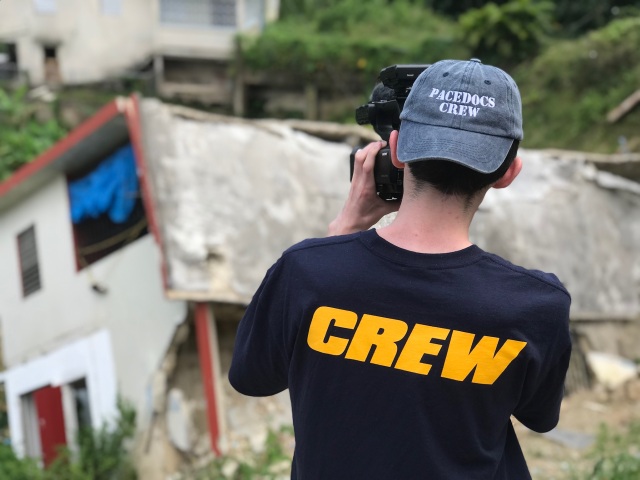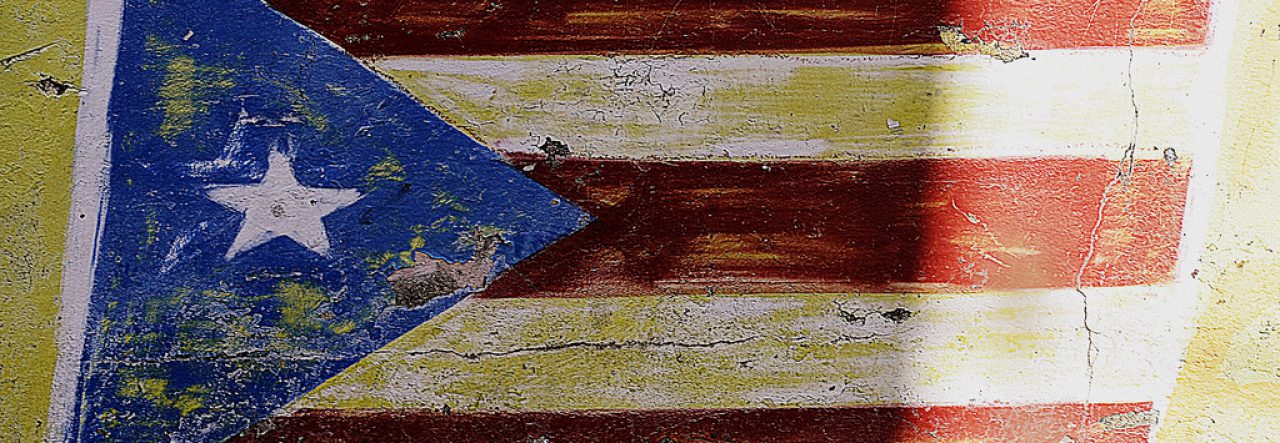
English:
On the fourth day of filming, Pace Docs crew traveled all over the island in order to capture the stories of the Puerto Rican people.
THE PEOPLE OF PONCE
Heniberto Ortiz, Ponce Native:
The first stop in Ponce was meeting with Heniberto Ortiz, a city local who told us about recovery efforts after Hurricane Maria. He is rebuilding his home with his own funds because, he says, he doesn’t want to take resources away from others who need it more.
Maritza Correa, Director, YMCA of Ponce Director:
The next stop was the YMCA of Ponce to meet with Maritza Correa the director of the building. Correa and her volunteers provided deliveries to those in need, organizing those deliveries to residents in the mountains.
Rafael Rodriguez Colon, Resident:
While following Correa on a delivery, Pace Docs had the chance to speak to Rafael Rodriguez Colon, a resident in the mountain town. Rodriguez Colon spoke about the immense fear he felt during the hurricane, explaining that at one point during Hurricane Maria, he felt I felt like he was going to die.The meet up in Sabana Grande and Yauco.
Jose Sepulveda, Sabana Grande Native:
Down the highway from Ponce in Sabana Grande, we met with Jose Sepulveda, a professional photographer who spoke about the excellent job Mayor Miguel “Papin” Ortiz did. For example, ensuring that supplies were distributed to everyone and that the town was back in order as quickly as possible.
Wanda Santiago Torres and Pablo Guzman Lopez, Yauco, CMTAS:
Pace Docs was then off to Yauco where they met with Wanda Santiago Torres, the director of Centro de Microempresas Tecnologías Agrícolas Sustentables de Yauco Inc. (CMTAS). The agricultural center for sustainability is teaching local residents about by creating local center, they hope will create more awareness in the area.
The Innovators of Utuado and the Surrounding Mountain Areas
Roberto Negron, OEM Utuado:
Meanwhile, over in Utado, Pace Docs met with Roberto Negron, the director of the Office of Emergency Management (OEM) for the municipality. Negron took the crew around devastated areas, which included a washed away bridge that was rebuild this week, six months after the hurricane. This bridge was the residents only highway out of their neighborhood, but thanks for a manmade, makeshift zip-line residents were able to send supplies, we experienced the ride across the river in an effort to feel that hardship.
Luis A. Rivera Santiago,Utuado Native:
During our driver through Utuado, we met Luis A. Rivera Santiago an Utuado Native who was trapped in his house for ten days after Hurricane Maria. He tells us that he was provided aid by a rescued helicopter on the tenth day, after he was savvy enough to cut the words help on his yard with a lawnmower. He like much of his neighbors remain without power or running water.
Lydia Mercado, Vega Baja Native:
Not far from Utuado in Vega Baja, Lydia Mercado spoke about how she could not wait for someone to come and help fix her home, so she fixed it herself. When asked what she is doing to prepare for the upcoming hurricane season Mercado- Vega said she is already prepping.
Saltiel Cruz Negron, Aguas Buenas Native:
In the topic of homes and constructions, we spoke to Saltiel Cruz Negron, a contractor that is helping restore homes following Hurricane Maria. He told us about the green energy movement in Puerto Rico and how after the hurricane more homeowners are asking for stronger built homes. Cruz Negron believes us, “Puerto Rican’s are ready to prepare better for next time.”
The Academics of the University of Puerto Rico Rio Piedras Campus Dr. Palmira Rios, UPR Professor:
Meanwhile, Dr. Palmira Rios disagrees. The graduate professor of the Public Administration at the University of Puerto Rico believes that Puerto Ricans did not properly prepare for Hurricane Maria and she feels policy needs to change before they can be ready for another disaster.
Samuel Suleiman, UPR Educational Technology Director
University Director:
Samuel Suleiman of the same university was impacted by the storm in a different way, losing fifteen years of his research on coral reef restoration. In the subject of reefs he tells us, “with the reefs being gone and destroyed, the waves are forming much bigger causing it to hit the shores and properties.”
Overall, it was an eventful day on the island, as we met many different residents and learned from their different perspectives about the past, present and future of the island.
Español:
En el cuarto día, el equipo de Pace Docs viajó por toda la isla para capturar las historias del pueblo puertorriqueño.
Los residentes de Ponce
Heniberto Ortiz, Nativo de Ponce:
La primera parada en Ponce fue una reunion con Heniberto Ortiz, un local de la ciudad que nos contó sobre los esfuerzos de recuperación después del Huracán María. Él está reconstruyendo su casa con sus propios fondos, porque él dice que no quiere quitar recursos a otros más necesitados.Maritza Correa, Directora de YMCA Ponce.
La siguiente parada fue el YMCA de Ponce para reunirse con Maritza Correa:
la directora del programa. Correa y sus voluntarios brindaron entregas a los necesitados, organizando esas entregas a los residentes en las
montañas.
Rafael Rodríguez Colon, Residente de Ponce:
Mientras siguiendo a Correa en una entrega, Pace Docs tuvo la oportunidad de hablar con Rafael Rodríguez Colón, un residente de la ciudad de la montaña. Rodríguez Colón habló sobre el inmenso miedo que sintió durante el huracán y explicó que en un momento durante el huracán María, pensó que moriría.Entre Sabana Grande y Yauco
José Sepúlveda, Nativo de Sabana Grande:
Abajo la carretera de Ponce en Sabana Grande, nos encontramos con José Sepúlveda, un fotógrafo profesional que habló sobre el excelente trabajo que hizo el alcalde Miguel “Papín” Ortiz. Por ejemplo, asegurando que los suministros se distribuyan a todos y que la ciudad haya vuelto a estar en orden lo más rápido posible.
Wanda Santiago Torres and Pablo Guzmán López, Yauco, CMTAS:
Pace Docs se fue a Yauco donde se encontraron con Wanda Santiago Torres, directora del Centro de Microempresas Tecnologías Agrícolas Sustentables de Yauco Inc. (CMTAS). El centro agrícola para la sostenibilidad está enseñando a los residentes locales como usar sobre esta tecnología, cual esperan que crea más conciencia en el área.
Los innovadores de Utado y las zonas montañosas circundantes
Roberto Negrón, OEM Utuado:
Mientras tanto, en Utado, Pace Docs se reunió con Roberto Negrón, el director de la Oficina de Gestión de Emergencias (OEM) del municipio. Negrón llevó el equipo de PaceDoc a áreas devastadas, que incluyeron un puente arrasado que se reconstruyó esta semana, seis meses después del huracán. Este puente era la única carretera de los residentes fuera de su vecindario, pero gracias a que los residentes, pudieron enviar suministros, a través del río con por un cable cruzando el rio.
Luis A. Rivera Santiago, Nativo Utado:
Durante nuestro viaje por Utuado conocimos a Luis A. Rivera Santiago, un nativo de Utuado que estuvo atrapado en su casa durante diez días después del Huracán María. Él nos dice que recibió ayuda de un helicóptero rescatado en los decimo día, después de que fue lo suficientemente inteligente de cortar sur jardín para leer, HELP, ayuda en inglés, cual fue visto por rescatistas.
Lydia Mercado, Vega Baja Nativa:
No muy lejos de Utuado en Vega Baja, Lydia Mercado habló de cómo no podía esperar por la ayuda del gobierno u organizaciones locales para arreglar su casa, así que lo arregló ella misma. Cuando le preguntamos cómo se estaba preparando para la próxima temporada ciclónica, Mercado-Vega dijo que ya había empezado.
Saltiel Cruz Negrón, nativo de Aguas Buenas:
En el tema de casas y construcciones, hablamos con Saltiel Cruz Negrón, un contratista que está ayudando a restaurar las casas después del huracán María. Nos dijo sobre el movimiento de energía verde en Puerto Rico y cómo después del huracán más propietarios están pidiendo casas más sólidas. Cruz Negrón cree que “los puertorriqueños están listos para prepararse mejor para la próxima vez”.
Los Académicos de la Universidad de Puerto Rico Recinto de Río Piedras
Dra. Palmira Ríos, Profesor de la UPR:
Sin embargo, la Doctora Palmira Ríos piensa todo lo contrario. La profesora de administración pública de la Universidad de Puerto Rico cree que los puertorriqueños no están preparados para el Huracán María y cree que los procedimientos deben cambiar antes de que pueda estar lista para otro desastre.
Samuel Suleiman, Director de Tecnología Educativa de la UPR
El director:
Samuel Suleiman de la misma universidad fue impactado por la tormenta de una manera diferente, al perder quince años de su investigación sobre la restauración de arrecifes de coral. Sobre el tema de los arrecifes, nos dice lo siguiente, “con los arrecifes desaparecidos y destruidos, las olas se están formando mucho más grandes, lo que hace que golpee las costas y las propiedades”.
En general, fue un día lleno de acontecimientos en la isla, ya que conocimos y aprendimos de muchos residentes que ofrecieron sus diferentes perspectivas sobre el pasado, el presente y el futuro de la isla.
This slideshow requires JavaScript.



